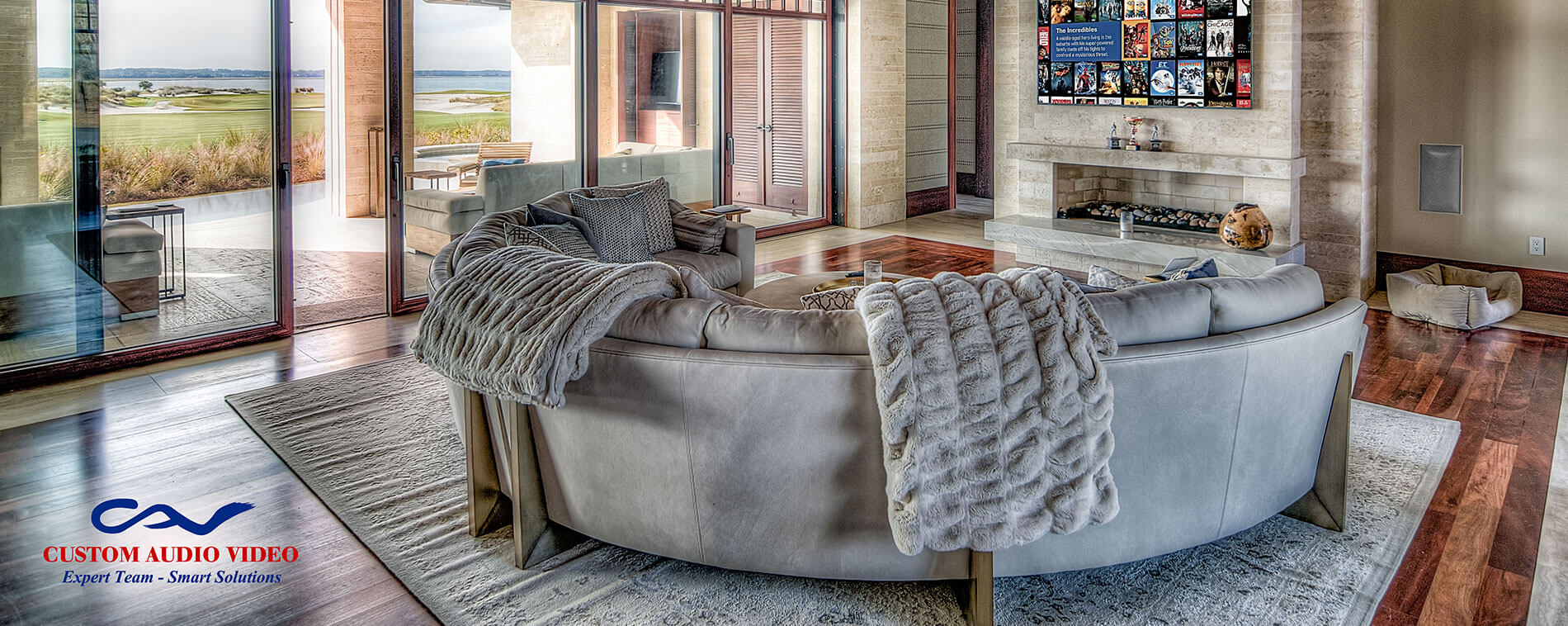VR vs AR
The booming virtual reality (VR) and augmented reality (AR) markets give consumers a whole new world of entertainment options as they look to improve their homes with the latest and greatest technology.
The VR and AR market is expected to grow to more than one billion users and have a worldwide value of more than $215 billion by 2021.1 Make sure you have an expert team of electronic specialists on your side when it’s time to upgrade.
“Virtual reality and augmented reality represent exciting breakthroughs in technology that will enhance entertainment and lifestyle options for consumers,” says Sandy Benson, owner of Custom Audio Video. “Before you make any decisions, however, it’s important to be fully informed about what this technology entails and what you need to make it work successfully.”
Here’s your guide to virtual reality and augmented reality:
What is the difference between VR and AR?
Virtual reality engulfs the user in a completely fabricated world, with the idea that it is difficult to determine what is real and what is not (think headset-enabled games). In augmented reality, users remain in touch with the real world while interacting with virtual objects (think Pokemon Go).
What companies are using VR and AR?
Apple, Google, Microsoft and Amazon are all using VR and AR technology in a variety of ways, from products like Google Glass to video game and interactive sports experiences. Apple and Amazon are working on applications to create AR experiences that allow you to project furniture or décor into your home using your smartphone or other devices to see how it looks in real-time. In addition, Apple is working on its own smart glasses, which would likely tie into their existing ecosystem of products.
What VR and AR products are available to consumers?
Much of the latest technology unveiled at the recent Consumer Electronics Show is not available in stores, but the products could be on the market soon for early adopters.
- Windows Mixed Reality – Microsoft offers a full package to get you up and running with VR, featuring high-powered computers optimized for VR, plug and play virtual headsets and motion controllers that respond naturally to your movements.
- Amazon AR View – iPhone and Android users can open this application through Amazon and use it to help see how a variety of items could work in your home. Simply click on an AR view-enabled item, and your phone will switch to camera mode, projecting the item where you would like to see it.
- HTC Vive Pro VR Headset – With amazing resolution and spectacular sound, this VR headset will fully engulf you as you play video games from your Xbox One or PS4, putting you right in the middle of the action.
- Vuzik Blade AR Smart Glasses – AR glasses have been much improved upon since their debut, and these specs project an interface on the right-hand lens. Working in tandem with your smartphone, you can connect virtually hands-free.
How do VR and AR work in the home?
The easiest way to connect to this new technology is through gaming consoles and computers. Xbox One and PS4 are configured to work with VR headsets, with games and apps that take advantage of the technology. Google Daydream headsets work in tandem with apps for VR experiences like live sports. When using VR, it’s important to set up your room to give yourself the space and freedom to move around without running into objects.
What are the strengths and weaknesses of VR and AR?
Virtual reality is an immersive experience, which is both its strength and weakness. Users have full sensory immersion in whatever content they are viewing, but the method takes viewers out of the “real world.” Augmented reality allows users to retain a connection and even interact with their surroundings, but the problem remains in how to execute AR in an efficient manner.
Make no mistake; however, VR and AR will play a major role in the future of technology, and if you are interested in using them in your home, working with professionals who understand and can recommend what will work best for you is critical.
“If you want to be on the cutting-edge of technology, you can’t go wrong with virtual and augmented reality,” says Iain Brown, CEDIA Certified Electronics System Technician II. “As the technology advances and changes, however, you want to make sure you work with experienced providers who can answer all of your questions and provide you with the right fit.”
Sources:
1. https://www.newgenapps.com/blog/6-vr-and-ar-statistics-shaping-the-future-of-augmented-reality-with-data
Cutting the Cord
The trend of cord-cutting, disconnecting cable TV services in favor of online streaming alternatives, jumped to its highest levels ever as of the 4th quarter of 2017.1 If you are among the 13.5 million American viewers rejecting cable companies in favor of over the top or OTT media platforms, here are some tips for making the transition smoothly.
1. Make sure you have the internet speed you need
To avoid issues with buffering, figure out how many devices are likely to be streaming at peak times in your household. For an average family streaming 4k Ultra HD content on multiple devices, internet speed should start at 25 megabits per second.2 If you’re not sure your current plan provides that level, run a speed test to see if you’re getting what you’re paying for. There are many free online speed testing options available.
2. Choose your devices wisely
Switching to on-demand streaming can be as basic as hooking up your phone or laptop to your television, but to create an optimum audio-visual experience, do some research in advance to decide whether you want a smart TV, a separate device like a Roku, Amazon Fire Stick, Apple TV or even your gaming console. Not sure what’s the best setup? Consult an expert.
“Yes, cord-cutting is about convenience, choosing what you want to watch when you want to watch it. But it’s also about creating a great entertainment experience in your home,” says owner Sandy Benson. “Syncing your systems in a way that makes sense for your family is definitely the way to go.”
3. Get the streaming services you’re most likely to enjoy
You’re spoiled for choice these days. Not only are the industry leaders like Netflix, Amazon Prime and Hulu offering great original content; cable and satellite providers like Comcast and DirectTV now provide streaming-only services. Premium channels like HBO and STARZ also offer stand-alone streaming. Keep an eye on costs if you’re cord-cutting to save money. Keep a total of individual monthly charges to be sure your OTT costs are still lower than your cable bill.
4. Think about what you want to watch live
You don’t have to give up watching the Oscars or NBA playoffs live. Sling TV, PlayStation Vue and Fubo TV are just some of the many services that allow you to pick your programming for less than cable costs. And if local news and weather are all you’re after, one of the many indoor or outdoor digital antennas with HD quality picture could be your answer.
5. Time your transition right
Check the terms of your cable deal to be sure you don’t incur a big fee for early termination. If the fee isn’t hefty, cutting the cord now may still save you money in the long run.
“We’re seeing more and more customers making the transition to OTT media,” says Sandy. “At one time, it was primarily a budget decision, but that isn’t necessarily the case anymore. Once people figure out that they can design an entertainment package that suits their viewing habits precisely, it’s hard to top that.”
Sources:
1. http://fortune.com/2018/03/01/cord-cutting-record-internet-tv/
2. https://www.pcmag.com/article2/0,2817,2478213,00.asp









